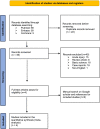Does Weaver-Dunn procedure have a role in chronic acromioclavicular dislocations? A meta-analysis
- PMID: 35168632
- PMCID: PMC8848947
- DOI: 10.1186/s13018-022-02995-9
Does Weaver-Dunn procedure have a role in chronic acromioclavicular dislocations? A meta-analysis
Abstract
Background: In treatment of chronic acromioclavicular (AC) joint dislocations, both the Weaver-Dunn procedure (WD) and CC ligament reconstruction (CCR) are recommended options due to the low possibility of healing of the coracoclavicular (CC) ligaments. The aim of this review was to determine whether CCR will yield favorable clinical and radiographic outcomes in the treatment of chronic AC dislocations.
Method: The Cochrane Library, EMBASE, and PubMed databases were searched for literature on chronic AC dislocations from data inception to June 30, 2021. Patient data were pooled using standard meta-analytic approaches. The Cochrane-Mantel-Haenszel method and variance-weighted means were used to analyze the outcomes. The Review Manager version 5.3 software (The Nordic Cochrane Centre, The Cochrane Collaboration, Copenhagen, Denmark) was used to calculate the heterogenicity, mean difference, and relative risk (RR) for all outcomes in the meta-analysis.
Results: The current analysis included four trials on this topic, and all AC joint dislocations were classified as Rockwood types III to VI. The pooled data showed that the CCR group had significantly better post-operative American Shoulder and Elbow Surgeons Shoulder (ASES) scores, Oxford Shoulder Scores (OSSs), and Nottingham Clavicle Scores (NCSs) than the WD group, with a significant difference (p < 0.001, p = 0.020, and p < 0.001, respectively). In terms of the post-operative Constant-Murley Scores (CMSs), there were no significant differences between the CCR group and the WD group (p = 0.100). The CCR group had significantly better post-operative abduction and flexion of the index shoulder than the WD group (p < 0.001 and p < 0.001, respectively). In terms of radiological outcomes, the post-operative coracoclavicular distance (CCD) with a 10 kg load was smaller in the CCR group compared to that in the WD group (p < 0.001). The overall surgical wound infection rate was 11.6% in the WD group and 12.9% in the CCR, respectively (p = 0.82).
Conclusion: The CCR group had better clinical outcome scores in the ASES, OOS, NCS, abduction, flexion, and external rotation than the WD group. In terms of radiological outcomes, the CCR group showed less displacement in weight-loaded post-CCD than the WD group, which indicated that the CCR provided more stability and resistance to deformation forces.
Keywords: Acromioclavicular joint; Reconstruction; Weaver–Dunn.
© 2022. The Author(s).
Conflict of interest statement
The authors declare that they have no competing interests.
Figures











References
-
- Tauber M, Gordon K, Koller H, Fox M, Resch H. Semitendinosus tendon graft versus a modified Weaver–Dunn procedure for acromioclavicular joint reconstruction in chronic cases: a prospective comparative study. Am J Sports Med. 2009;37:181–190. - PubMed
-
- Kibler WB, Sciascia AD, Morris BJ, Dome DC. Treatment of symptomatic acromioclavicular joint instability by a docking technique: clinical indications, surgical technique, and outcomes. Arthroscopy. 2017;33:696–7082e2. - PubMed
-
- Parnes N, Friedman D, Phillips C, Carey P. Outcome after arthroscopic reconstruction of the coracoclavicular ligaments using a double-bundle coracoid cerclage technique. Arthroscopy. 2015;31:1933–1940. - PubMed
Publication types
MeSH terms
Grants and funding
LinkOut - more resources
Full Text Sources
Medical

